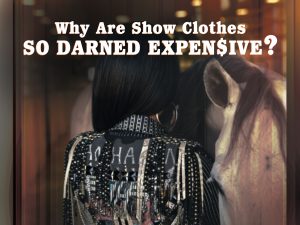Why Are Show Clothes So Darned Expensive?
Click here to read the complete article
It’s true that nothing quite compares to the feeling of wearing a dynamite outfit in the show ring. Your confidence, attitude and, well, yes, happiness, from that sensation can have a big impact on your performance and your eye appeal.
But dropping a car payment on a piece of clothing, even for the majors, seems like a little much at times. That begs the question: why are those fancy show clothes so expensive?
Leave it to The Equine Chronicle to learn from top designers about the intricacies behind the design process and cost breakdown of materials, labor, time, and more.
Details Are Everything
One glance at a jacket covered in expensive crystals and fittings and it’s clear that a lot went into its creation. But where does the cost come from? What parts and pieces are more expensive than others? “The cost includes fabrics and leathers, but the majority of the cost is in stones, especially the larger, sewn-on crystals,” explains Lindsay Klempel of Silver Lining Custom Western Show Apparel based in Camano Island, Washington.
“Each garment basically uses the same materials, such as the base, interfacing, zippers, and trim including crystals,” says Carolyn Berry of Berry Fit Company of New Philadelphia, Ohio. However, she explains that when Swarovski crystals became a staple for show clothing, it nearly doubled the cost of a garment.
According to Penny Young of Showtime Show Clothing of Purcell, Oklahoma, designers that offer one-of-a-kind creati-ons must keep a good stock of interesting decorations at their fingertips. “We need a large inventory of fabrics, ultra suede, crystals, chains, spikes, beads, conchos, jewelry, leather, zippers, shoulder pads, thread, and glues, etc. We keep it in stock so we can get ideas of what to incorporate into the next design,” she says.
The supply costs associated with clothing designers that offer unique designs contrast greatly in comparison to mass producers of clothing, Young confides. “Manufacturers that mass produce can order the exact amount of zippers, buttons, yards of fabric, because they know they will have no waste,” she explains.
The Intangibles











